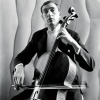Master Class: Bloch Schelomo, B.39
Schelomo: Rhapsodie Hébraïque for Violoncello and Orchestra is the final piece in Ernest Bloch’s Jewish Cycle. Composed between 1915 and 1916, it premiered on May 3, 1917, performed by cellist Hans Kindler under the baton of Artur Bodanzky at Carnegie Hall. Bloch sought to explore his musical identity and express his vision of Jewish music at a time when the Jewish national state had not yet been established.
Originally envisioned as a vocal piece based on the Book of Ecclesiastes, Schelomo evolved after Bloch encountered cellist Alexandre Barjansky, whose playing inspired him to utilize the cello as the voice of King Solomon. The Hebrew name “Schelomo” reflects this connection. In a 1932 reflection, Bloch described Schelomo as a “psychoanalysis” of his creative process, where the solo cello symbolizes King Solomon, while the orchestra represents his surrounding world and life experiences. At times, the orchestra reflects Solomon’s thoughts, with the cello conveying his words.
About

Gregor Piatigorsky
by ROBERT BATTEY (active Washington DC area cellist, teacher and writer) One of the pre-eminent string players of the 20th…
See More